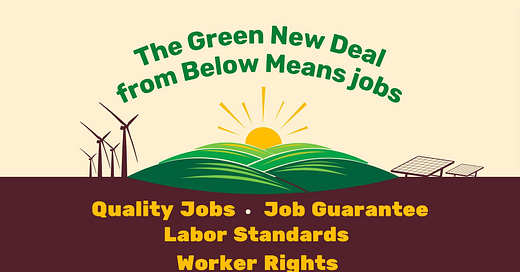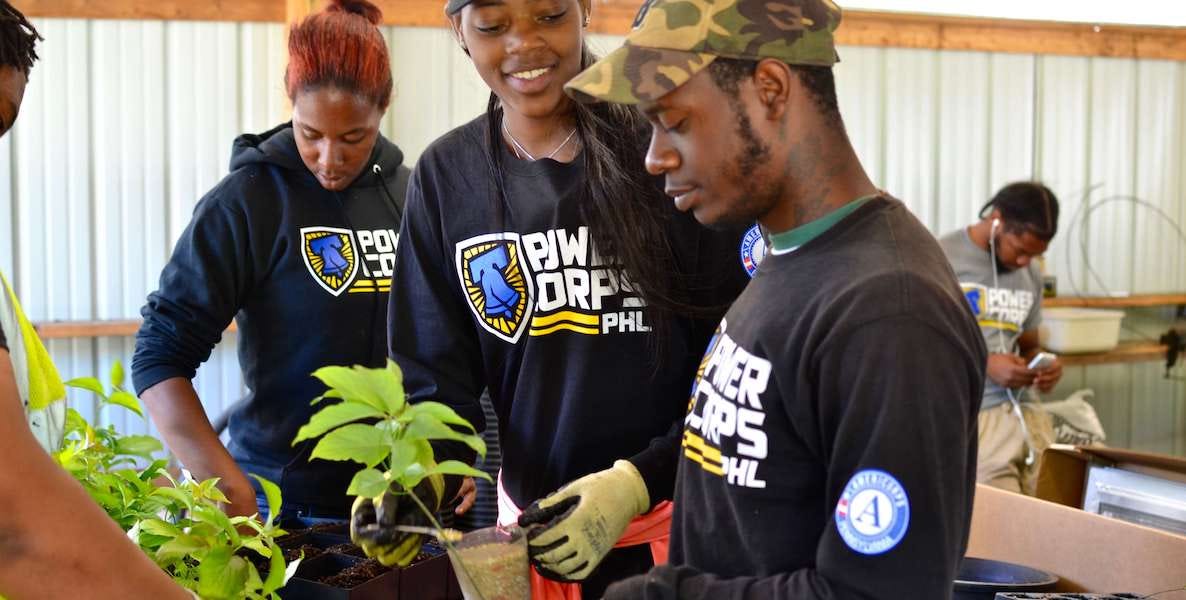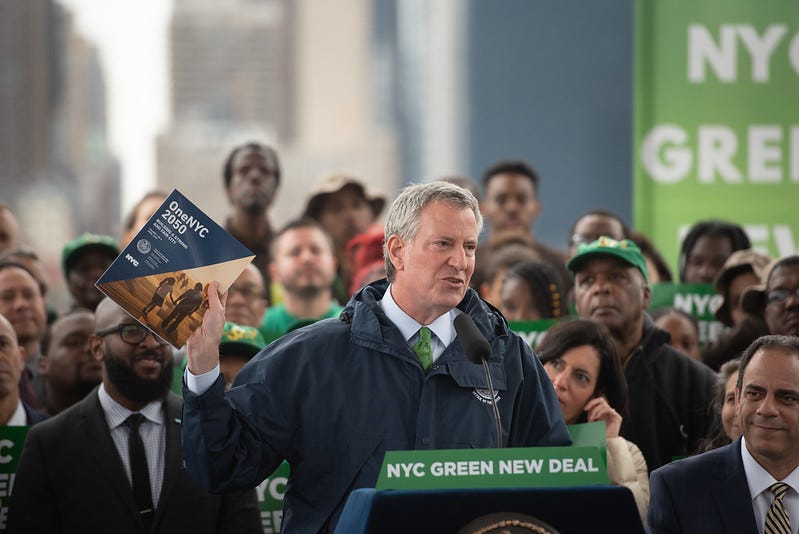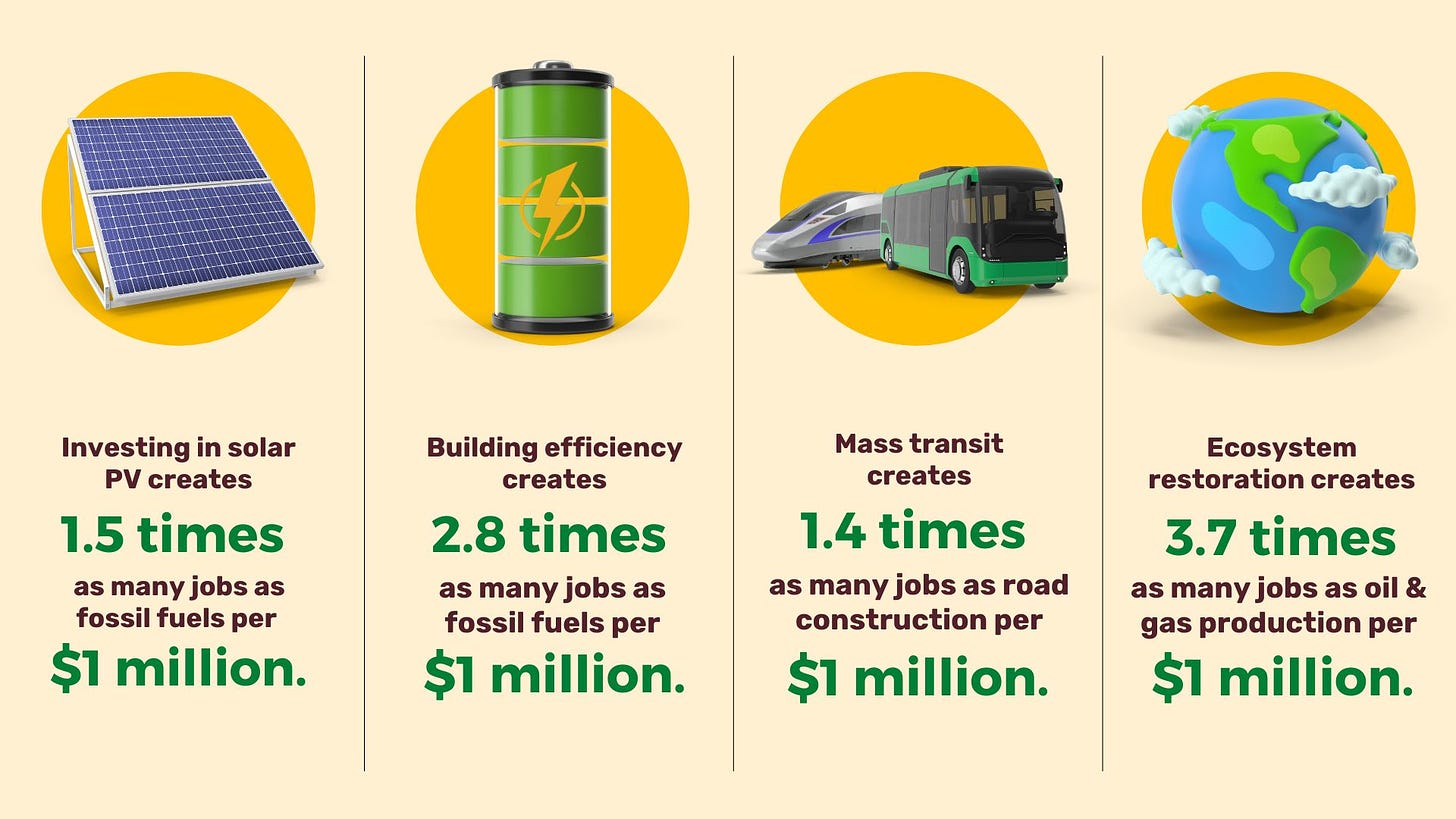Listen to the audio version >>
Despite opposition to a national Green New Deal by rightwing politicians and the fossil fuel industry, many “Little Green New Deals” are under way at the local and state level – and they are already expanding the number and improving the quality of jobs. This Commentary starts with the youth jobs corps that have developed in Green New Deal cities and others with climate protection programs. It reviews the jobs that are already being created by state and local Green New Deal from Below programs and evaluates how many could be created by a fully developed Green New Deal. The next Commentary will examine how the Green New Deal from Below is making green jobs be good jobs.
While the Green New Deal is often thought of as a remedy for climate change, a central part of its focus has always been on jobs and economic inequality. The original Green New Deal resolution noted a “4-decade trend of wage stagnation, deindustrialization, and antilabor policies.” That had led to “hourly wages overall stagnating since the 1970s”; the “erosion of the earning and bargaining power” of workers; and “inadequate resources for public sector workers to confront the challenges of climate change” at local, state, and federal levels. There was “the greatest income inequality since the 1920s” with a difference of “20 times more wealth between the average white family and the average black family” and a gender earnings gap that results in “women earning approximately 80 percent as much as men.”[1]
While the US unemployment rate has gyrated between record highs and record lows over the past two decades, the condition of US jobs has consistently deteriorated. More and more jobs have become low-paid, insecure, and contingent. They are often temporary, part time, dead-end, with few or no benefits. While difficult to quantify, harassment, discrimination, speed-up, arbitrary punishment, and threats of discipline and dismissal are reported by a growing proportion of workers.
The Green New Deal proposed a mobilization to create millions of jobs protecting the climate. But it also proposed to use climate mobilization as a vehicle to transform the world of work. It included as part of its plan[2]:
Quality jobs: high-quality union jobs that pay prevailing wages, hires local workers, offers training and advancement opportunities;
Job guarantee: guaranteeing a job with a family-sustaining wage, adequate family and medical leave, paid vacations, and retirement security to all people;
Worker rights: the right of all workers to organize, unionize, and collectively bargain free of coercion, intimidation, and harassment; and
Labor standards: labor, workplace health and safety, antidiscrimination, and wage and hour standards across all employers, industries, and sectors.
While many of these objectives require action by the federal government, Green New Deals and similar initiatives around the country are making building blocks for them at local and state levels.
Civilian Climate Corps in Cities
Nurturing Tomorrow’s Workforce| Workforce development programs don’t always live up to their mission. PowerCorpsPHL exceeds theirs | By Jessica Blatt Press, Feb. 11, 2020
One of the most famous agencies of the original New Deal was the Civilian Conservation Corp (CCC) which provided jobs and training for three million young Americans during the Great Depression of the 1930s. A Civilian Climate Corps has been a central proposal of the Green New Deal – and such corps are actually being developed by the Green New Deals from Below. They are often centered in the poorest neighborhoods and have as their objective, along with climate protection, the reduction of crime and violence through youth employment.
When Boston’s Green New Deal wanted to establish a youth green jobs corps, they looked to PowerCorpsPHL for a model. PowerCorpsPHL was established in 2013 by Philadelphia city agencies and AmeriCorp. More than 600 young people have been through its programs. A new cohort of 60 enter the Corp each spring and fall. 60 percent of them have adult criminal records.[3] To join the Corps they must have a GED or high school diploma.
During the first phase of the program, which lasts 17 weeks, new Corp members are paid $10 per hour to engage in work-readiness, career-exploration, and team-building activities like planting trees. During the second phase, which lasts 19 to 46 weeks, graduates of Phase 1 receive training in “industrial academies”: The Urban Forestry Academy, the Green Stormwater Infrastructure Academy, and the Solar and Electrical Academy. They are paid $11 per hour and work with mentors from government agencies, nonprofits, and industry.
Attrition is 25% in phase one and only 15% in phase 2. Philadelphia’s criminal recidivism rate is 45 percent; for PowerCorpsPHL members it is 8 percent. PowerCorpsPHL connects more than 90% of its graduates to jobs or higher education – and 92% of them succeed. The Corp maintains a full-time social worker to help with needs like access to medical care and childcare and provides lifetime support services for all graduates.
Cashmir Woodward, a single mother with a juvenile record, was a low-paid home health aide. She heard about PowerCorpsPHL from a friend and signed up. A staff member helped her get childcare, social security benefits for her son, and expunging of her criminal record. She was trained in green stormwater infrastructure. She says,
I felt like what I was doing before PowerCorpsPHL wasn’t enough, and now I can have a real impact on our city and its future. I want other young people, including those with records, to know that PowerCorpsPHL will accept you without judgement and work with you, no matter what.
Mayor Bill de Blasio announces New York City’s Green New Deal at Hunter’s Point South Park on Monday, April 22, 2019. NYC.com | Photo Credit: Michael Appleton/Mayoral Photography
In April 2019 Mayor Bill de Blasio announced New York City’s Green New Deal. It promised investments, legislation, and action to reduce emissions nearly 30% by 2030.[4] In 2021 the New York Mayor’s office of Criminal Justice provided a $37 million grant to create a Civilian Climate Corp. The mission of the Corps is to help create the workforce needed for the city’s climate protection program by providing training and jobs to people in neighborhoods affected by gun violence.[5]
New York City’s Civilian Climate Corp is run by BlocPower, a start-up founded in 2014 by Donnel Baird, a former Brooklyn community organizer. By 2021 BlocPower had retrofitted more than 900 multifamily apartment buildings, houses of worship, and small businesses. And it had trained more than 800 prospective heat pump and solar panel installers from the same communities where it was conducting retrofits.[6] According to Baird,
We are going into the lowest-income communities, where folks are at risk of gun violence—personally, their families, their communities—we’re training them on the latest, greatest software to install green infrastructure in urban environments, in rural environments. That’s going to solve not only crime rates in low-income communities in New York City, it’s going to solve the business problem of the shortage of skilled construction workers across America.
The Civilian Climate Corps recruits workers from low-income communities with high rates of gun violence. They receive $20 per hour during their training. The Corps provides one month of classes in workplace etiquette and business communication followed by two months of technical training, including low-voltage electrical work, HVAC installation, and workplace safety training. Most workers then continue with on-site apprenticeships. By 2023, 1,700 people, 80% of whom had been unemployed or underemployed, had graduated from the Corps’ training program. More than 400 participants secured jobs in related fields, and 60% had completed the Occupational Safety and Health Administration training program, often required for such employment.
One of those graduates is Robert Clark. Perhaps because of a felony conviction for burglary, Clark had been unable to find any but low-paid, dead-end jobs. Then he was recruited to the Civilian Climate Corp where he was paid $20 per hour to learn how to install electric heat pumps, take care of electric vehicle charging stations, and conduct 3D image modeling of buildings due for renewable energy retrofits. He has received a certification for his work with the Corps and hopes to go back to school in engineering.
In October 2022 New York City announced a $54 million expansion of the program, which will allow 3,000 more New Yorkers to participate in the following year. BlocPower is exploring replications in Ithaca NY, Menlo Park CA, and elsewhere. It hopes its program can “serve as a model for future national programming.”
Civilian Climate Corps in States
California Climate Action Corps in San Jose| Credit: California Volunteers
States are also developing climate corps. In September 2020, California launched the California Climate Action Corps, the country’s first statewide corps of its kind with the mission of empowering Californians to take meaningful action to protect their homes, health, and communities against the impacts of climate change. This initiative engages Californians through a variety of levels and activities, from an hour at home to a full year of service.[7] It includes Youth Jobs Corps in more than 25 California cities and counties.[8]
In September 2021 Colorado established the Colorado Climate Corps to place AmeriCorps members in 55 counties across the state to protect public lands and help low-income communities brace for the climate crisis.[9] In 2022 the Colorado Climate Corps placed the first 633 AmeriCorps members of the Climate Corps on the ground. They focused on wildfire mitigation and water and energy efficiency. The program rapidly expanded to include supporting local governments and non-profits in planning for and addressing sustainability and climate change issues.[10]
These climate jobs corps are creating models that can be greatly expanded for other cities and states – and for the US as a whole. They offer a foothold for those who have been marginalized in the labor market. They provide opportunities in communities that have been plagued with high unemployment and resulting crime and violence. And they deliver the training and experience necessary for a greatly expanded workforce able to meet the objectives of climate protection and the Green New Deal.
Green New Deal Jobs
The shift to a climate-safe economy is happening too slowly, but it is happening. It is happening in part because fossil fuels keep getting more expensive relative to renewable energy. It is happening because many local communities refuse to tolerate the devastation wrought by fossil fuel extraction and burning. And it is happening because of climate protection efforts by governments and civil society.
A frequently asked question is this: How many jobs will the Green New Deal and the shift to a climate-safe economy produce? Renewable energy and energy efficiency create far more jobs than fossil fuel energy. A study by the World Resources Institute found that:
Investing in solar PV creates 1.5 times as many jobs as fossil fuels per $1 million.
Building efficiency creates 2.8 times as many jobs as fossil fuels per $1 million.
Mass transit creates 1.4 times as many jobs as road construction per $1 million.
Ecosystem restoration creates 3.7 times as many jobs as oil & gas production per $1 million.
So the result of a shift from fossil fuels to climate-safe energy is undoubtedly more jobs.[11]
How to quantify actual and potential job creation is, however, a difficult and uncertain matter. While economists make estimates of the job creation effects of various policies all the time, they generally must rely on unproven – sometimes unprovable — assumptions. They also necessarily disregard unpredictable factors like wars and trade wars, booms and busts, pandemics, regime change, and policy shifts. Results are also affected by the hopes and fears of those who conduct the studies – and those who commission them. Having personally supervised a number of such studies, I can testify that those conducting the studies are selected in part on the basis of the sponsors’ expectations of their results, and that the researchers are well aware of these expectations. While I will cite the results of several such studies below, I encourage readers to treat their results with appropriate skepticism.
There is no question that local and state Green New Deals are creating thousands of jobs. The exact number is almost impossible to calculate, but we have seen examples just in the Green New Deals described in this series of Commentaries:
The Los Angeles Green New Deal plan laid out 445 initiatives estimated to create 300,000 green jobs by 2035 and 400,000 by 2050.
The Ithaca Green New Deal planned to create 1,000 jobs in the region in in its first 1,000 days.
The Illinois Climate and Equitable Jobs Act was expected to create thousands of new jobs. The solar industry alone expected to increase its Illinois workforce by almost 50% in 2022.
The “California Climate Jobs Plan” proposed by 20 California unions would create more than a million jobs, including 418,000 clean energy jobs per year and 626,000 additional jobs per year through investments in related areas such as water infrastructure, leaky gas pipelines, public parks, and roadways.
According to California Gov. Gavin Newsom, the new laws passed in 2022 will create four million jobs.
IBEW 569 members have logged millions of work hours building more than a gigawatt of solar and wind projects, installing rooftop solar and electric vehicle charging stations at homes and businesses, and constructing large energy storage projects. Local 569 brought hundreds of local residents into the IBEW who were able to build renewable energy projects in their local communities.
In Portsmouth, VA, the Spanish wind turbine manufacturer Siemens Gamesa plans for 310 jobs to make preparations for a new offshore wind farm. 260 of them would be in a finishing plant where blades are painted and assembled. In New Jersey, Ørsted of Denmark and EEW of Germany plan to open a factory to build the steel foundations of turbines—called monopiles—that would provide up to 500 jobs. In New York, Marmen of Canada, Welcon of Denmark, and Smulders of Belgium are planning a plant to make steel towers for offshore wind turbines; it will employ up to 350 people.
These examples are part of a much more extensive growth of green jobs throughout the American economy. According to the annual report “Clean Jobs America 2022,”[12] more than three million Americans work in clean energy, including renewable energy, energy efficiency, storage, grid modernization, and clean fuels. Jobs building electric vehicles grew by a dramatic 26 percent in 2022. Conversely, fossil fuel jobs fell 4 percent. Clean energy and clean transportation now employ more than 40 percent of all energy workers in America. These numbers are based on U.S. government surveys, not on estimates or projections.
There have been a variety of studies that estimate how many new green jobs will be created by the 2022 Inflation Reduction Act. A study by the Political Economy Research Institute at the University of Massachusetts Amherst finds that the more than 100 climate, energy, and environmental investments in the Inflation Reduction Act will create more than 9 million good jobs over the next decade – nearly a million a year. That includes 5 million jobs in clean energy, 900,000 in clean manufacturing, 400,000 in clean transportation, 900,000 in efficient buildings, 150,000 in environmental justice, and 600,00 in natural infrastructure.[13]
Another study by the Energy Futures Initiative found that the Inflation Reduction Act will create 1.5 million climate and energy security jobs by 2030 – seven years from now. Over 100,000 will be in manufacturing, with 60,000 coming from battery production alone. Nearly 600,000 jobs will be created in the construction sector, for example constructing electrical transmission lines. The electric utility sector will gain 190,000 jobs.[14]
While these two studies illustrate how different economists can come up with different job projections even for policies already defined in legislation, they also indicate that the scale of job creation just from the Inflation Reduction Act is likely to be very substantial.
The Inflation Reduction Act represents only a fragment of what is necessary to eliminate greenhouse gas emissions, let alone realize the full Green New Deal program. While specific Green New Deal proposals vary, there is no question that the number of jobs created by a national Green New Deal would be far greater. America’s Zero Carbon Action Plan, to take one plan among many, develops a scenario for the U.S. economy to achieve net-zero CO2 emissions by 2050. It estimates that this will generate 4.2 – 4.6 million jobs per year between 2020 and 2050 – cutting the average unemployment rate nearly in half.[15] Another study by Mark Jacobson of the Solutions Project found that transitioning to 100% renewable electricity and heat by 2050 would create more than 4.7 million permanent jobs. And these studies don’t take into account the other job creation programs that would be included in a full Green New Deal.[16]
The next Commentary in this series, “The Green New Deal from Below and the Future of Work,” will explore how the Green New Deal from Below is making green jobs be good jobs.
[1] H.Res. 109 – 116th Congress. https://www.congress.gov/bill/116th-congress/house-resolution/109/text
[2] S. Res. – 118th Congress, 1st Session https://www.markey.senate.gov/imo/media/doc/gnd_resolution_-_042023.pdf
[3] Jessica Blatt Press, “Nurturing Tomorrow’s Workforce,” The Philadelphia Citizen, Feb 11, 2010. https://thephiladelphiacitizen.org/powercorpsphl-philadelphia/
[4] “Action on Global Warming: NYC’s Green New Deal,” City of New York, April 22, 2019. https://www.nyc.gov/office-of-the-mayor/news/209-19/action-global-warming-nyc-s-green-new-deal#/0
[5] Michelle Ma, “This New York program has trained 1,700 workers for green jobs,” Fast Company, January 11, 2023. https://www.fastcompany.com/90833282/this-new-york-program-has-trained-1700-workers-for-green-jobs-and-its-only-getting-started
[6] Ainsley Harris, “BlocPower is turning every home into the equivalent of a Tesla,” Fast Company, March 8, 2022. https://www.fastcompany.com/90721881/blocpower-donnel-baird-electrify-homes
[7] “California Climate Action Corps,” Office of the Governor. https://www.californiavolunteers.ca.gov/about-california-climate-action-corps/
[8] “Californians for All Youth Jobs Corps, Office of the Governor. https://www.californiavolunteers.ca.gov/californiansforall-youth-jobs-corps/
[9] Sam Brasch, “As Colorado Announces Its Own Climate Corps, Democrats Push for a Far More Expansive National Version,” CPR News, September 11, 2021. https://www.cpr.org/2021/09/11/colorado-climate-corps-democrats-national-version/
[10] “22 Annual Report Serve Colorado, Office of Lt Governor Dianne Primavera. https://drive.google.com/file/d/1Xz-UTkG3UmdDDoYUc4uejKqrqg5rUcq8/view
[11] Joel Jaeger et al, “The Green Jobs Advantage: How Climate-friendly Investments Are Better Job Creators,” World Resource Institute, October 18, 2021. https://www.wri.org/research/green-jobs-advantage-how-climate-friendly-investments-are-better-job-creators
[12] “Clean Jobs America 2022,” August 3, 2022. https://e2.org/reports/clean-jobs-america-2022/
[13] “9 Million Good Jobs from Climate Action – The Inflation Reduction Act of 2022,” BlueGreen Alliance and Political Economy Research Institute (PERI). https://www.bluegreenalliance.org/wp-content/uploads/2022/08/BGA-IRA-Jobs-Factsheet-8422_Final.pdf
[14] “Jobs, Emissions, and Economic Growth – What the Inflation Reduction Act Means for Working Families,” EFI Foundation, January 17, 2023. https://energyfuturesinitiative.org/reports/jobs-emissions-and-economic-growth-what-the-inflation-reduction-act-means-for-working-families-jobs-emissions-and-economic-growth/
[15] “America’s Zero Carbon Action Plan,” The Zero Carbon Consortium, 2020, Chapter 3, p. 51. https://irp-cdn.multiscreensite.com/6f2c9f57/files/uploaded/zero-carbon-action-plan-exec-summary.pdf
[16] Mark Jacobson et al, “Zero air pollution and zero carbon from all energy at low cost and without blackouts in variable weather throughout the U.S. with 100% wind-water-solar and storage, Department of Civil and Environmental Engineering, Stanford University. Stanford, CA., 2021. https://web.stanford.edu/group/efmh/jacobson/Articles/I/21-USStates-PDFs/21-USStatesPaper.pdf








